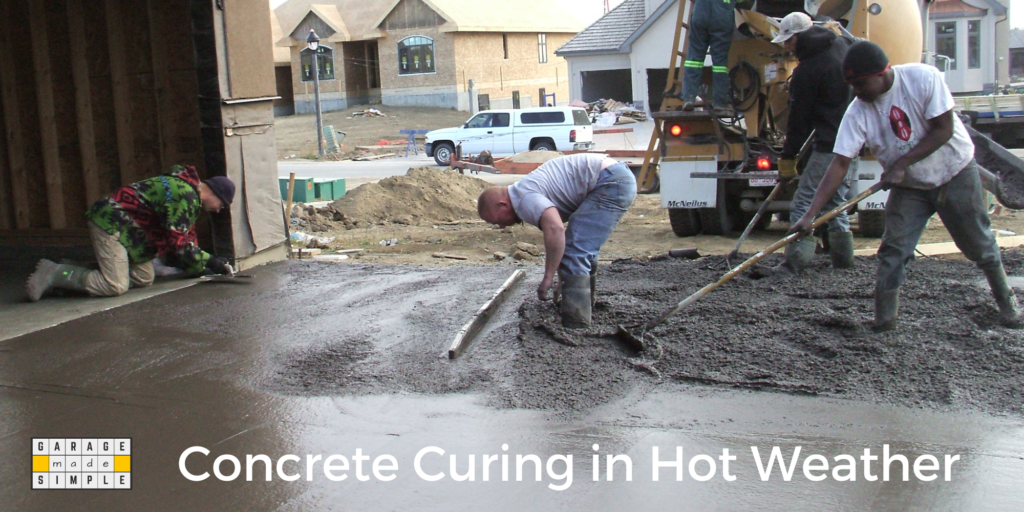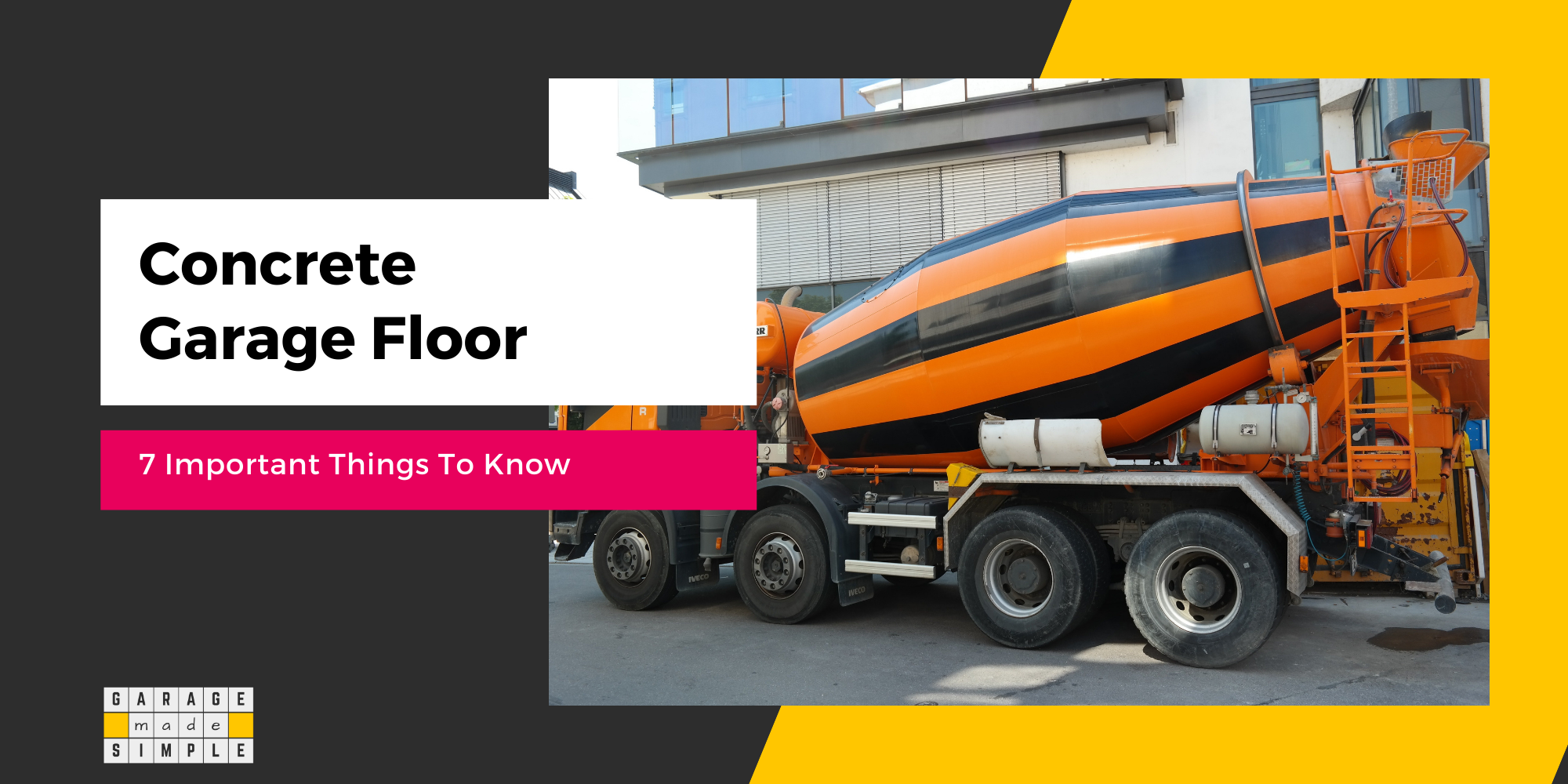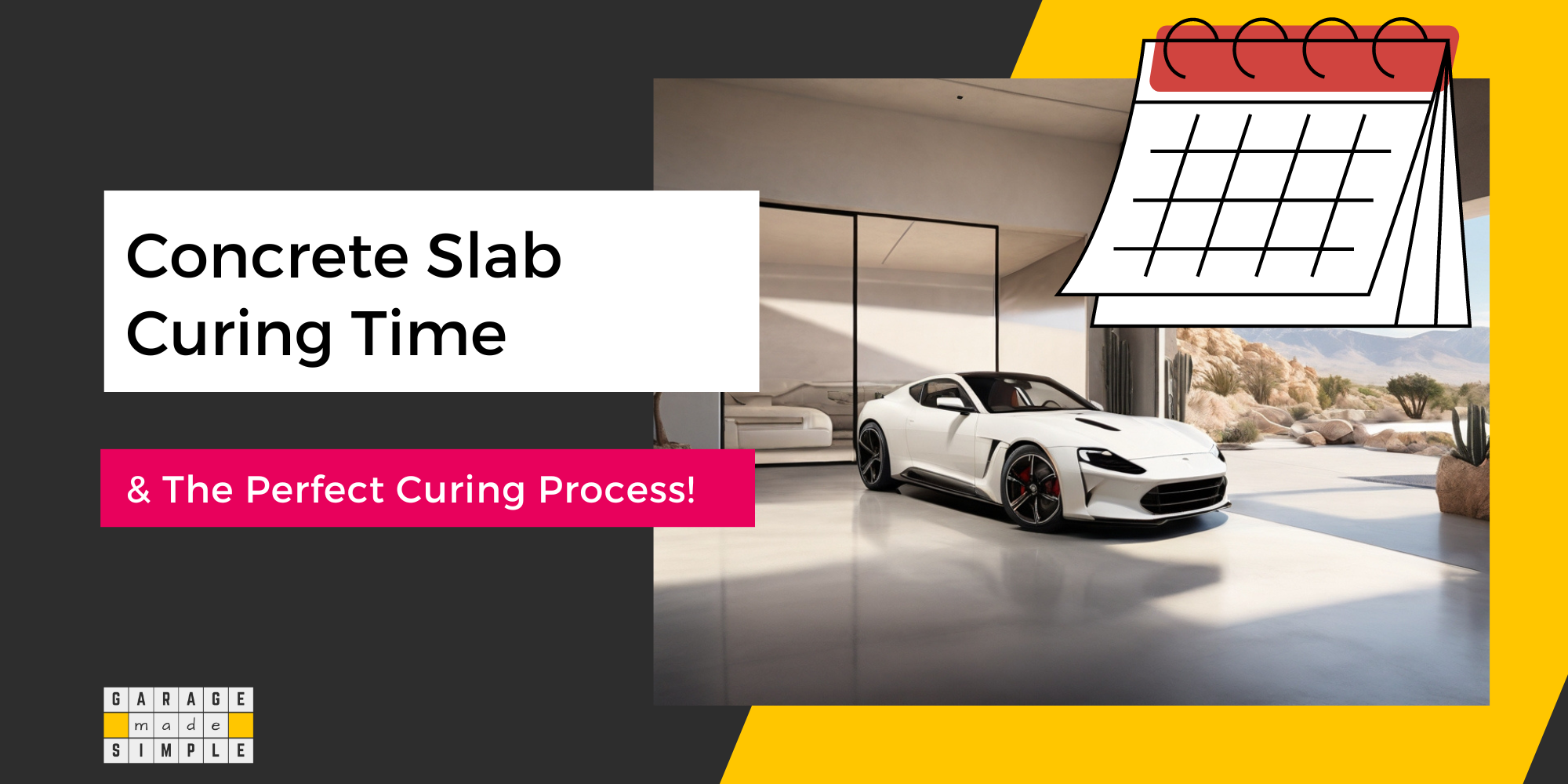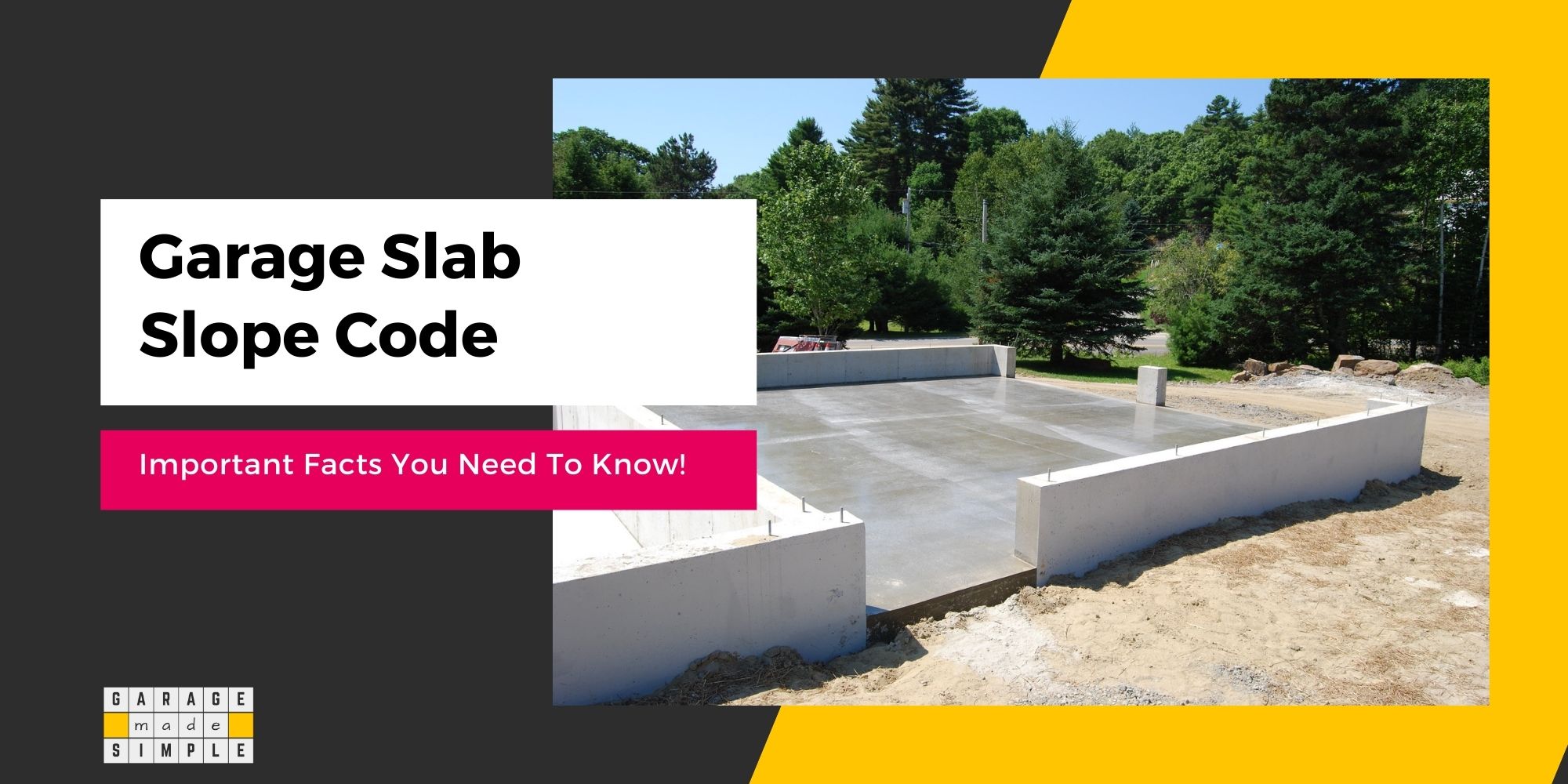9 Tips for Curing Concrete in Hot Weather: A Useful Guide!
garagemadesimple.com is a participant in the Amazon Services LLC Associates Program, an affiliate advertising program designed to provide a means for sites to earn advertising fees by advertising and linking to Amazon.com . The website is also an affiliate of a few other brands.
You can pour a garage slab during peak summer months, but be aware that curing concrete in hot weather demands special attention to ensure a durable and resilient structure.

The concrete curing process, which begins immediately after finishing, is crucial for the concrete’s strength and longevity, particularly in hot, dry conditions. To mitigate the adverse effects of intense heat, it’s essential to employ effective strategies right from the outset.
Environmental factors typically impede curing concrete in hot weather. You have to contend with low humidity and strong winds. These conditions accelerate the evaporation of moisture from the concrete, potentially leading to premature drying and weakening of the structure.
Curing Concrete in Hot Weather: Problems & Preparation
Curing concrete during hot weather poses challenges, including early water loss and rapid drying, leading to issues like strength reduction, cracking, and finishing difficulties. To tackle these problems, proactive measures must be taken during preparation.
Concrete should ideally be poured when temperatures are below 80°F to prevent overheating and premature drying. Knowing the temperature forecast and planning the time of concrete pour are critical to ensure proper curing.
Start early in the morning or late in the evening to avoid extreme heat. Ensure readiness – both your team and equipment should be prepared to work swiftly upon concrete arrival, as prolonged mixing can elevate temperature significantly.
Tips for Curing Concrete in Hot Weather
Here are some expert tips that will be very helpful in getting good results when curing concrete in hot weather.
1. Time the Concrete Pour
Steer clear of pouring during peak heat hours, usually midday to mid-afternoon. It is best to pour concrete for your garage slab either in early morning or late in the afternoon. Actually, late afternoon is best as the poured concrete will not be subjected to intense heat for 12-18 hours.
Selecting the right time for pouring concrete in hot weather is crucial for proper curing due to following factors:
- Temperature Control: Pouring concrete during the hottest part of the day can lead to rapid evaporation of moisture from the surface, hindering proper hydration of the cement. This can result in weaker concrete with reduced strength and durability.
- Workability: High temperatures can cause concrete to set faster, making it challenging to work with and finish properly. Pouring during cooler hours allows for better control over the concrete’s consistency and placement, ensuring a smoother finish.
- Reduced Cracking: Pouring concrete during cooler hours minimizes the risk of thermal cracking. Rapid temperature changes, typical during hot days, can cause internal stresses in the concrete, leading to cracks. Pouring during cooler times reduces temperature differentials and helps prevent cracking.
- Worker Safety: Pouring concrete during cooler hours provides a more comfortable working environment for the construction crew. Your crew will be a lot more productive!
2. Use a Larger Crew
Ensure you have enough hands to complete the job swiftly. Using a larger crew during concrete pouring in hot weather helps as under:
- Efficiency: A larger crew enables faster completion of the work, minimizing the time concrete is exposed to hot weather conditions. This reduces the risk of premature drying and ensures proper curing.
- Workforce Fatigue: Working in hot weather can lead to fatigue and decreased productivity among the crew. By having a larger team, workload can be distributed more evenly, reducing individual strain and maintaining productivity levels throughout the pour.
- Timely Placement: Concrete must be placed and finished promptly to prevent issues such as premature setting and surface drying. With a larger crew, tasks like pouring, leveling, and finishing can be carried out simultaneously, ensuring timely placement and proper finishing of the concrete.
- Quality Control: Proper curing requires attention to detail during placement and finishing. A larger crew allows for more eyes on the job, enhancing quality control measures and reducing the likelihood of errors or defects in the finished product.
- Adaptability: Hot weather conditions can be unpredictable, requiring quick adjustments to pouring and curing methods. A larger crew provides greater flexibility to adapt to changing conditions and implement necessary measures to ensure proper curing and quality of the concrete.
3. Select the Right Concrete Mix
The water-cement ratio in the concrete mix is a critical factor in determining the ultimate strength of the concrete slab. A ratio of 0.5 or slightly lower is optimal.
However, during hot weather conditions you may be tempted to increase this ratio to improve workability and to compensate for excessive water loss due to evaporation. Be wary as this will result in:
- Lower compressive strengths.
- Non-uniform quality throughout the concrete slab.
- Increased risk of cracking due to lower tensile strength and high shrinkage.
- Dusting and scaling caused by excess water bringing fines to the surface.
- Sand streaks from excess water bleeding up form sides, leaving unsightly streaks.
- Contamination from excessive water leading to quality problems.
- Increased water permeability of the garage slab.
4. Incorporate Appropriate Admixtures
Rather than change the water-cement ratio of the concrete mix, incorporate retarders or accelerators in the concrete mix to adjust concrete setting times, ensuring workability and a superior finish in hot temperatures.
Adjusting Concrete Mix for Hot Weather:
- Retarding admixtures are useful for controlling concrete in warm weather by delaying setting time.
- They can be added at the plant or on-site to counteract the rapid setting caused by hot temperatures.
- Retarders can come as straight retarders or water-reducing and retarding admixtures, which may also increase air content.
- Excessive use of retarder can lead to surface crusting and reduced flatness, potentially causing delamination.
- For extreme situations or long-distance transportation, hydration controlling admixtures can be used to delay set by up to 5 hours, facilitating concrete delivery over long distances without compromising quality.
5. Apply a Suitable Curing Compound:
Apply a curing compound to limit moisture loss in hot conditions, helps prevent premature drying and cracking. Here are some options:
Curing Compounds for Concrete Curing in Hot Weather:
- Polymer-Based Curing Compounds: These compounds form a protective film over the concrete surface, reducing moisture loss due to evaporation.
- Wax-Based Curing Compounds: Wax-based compounds create a barrier that prevents moisture loss from the concrete surface.
- Resin-Based Curing Compounds: Resin-based compounds penetrate the concrete surface, forming a protective layer that prevents moisture evaporation.
- Chlorinated-Rubber Based Curing Compounds: These compounds form a thin film over the concrete surface, effectively sealing in moisture and preventing rapid drying.
- PVA-Based Curing Compounds: Polyvinyl acetate (PVA) based compounds offer excellent moisture retention properties, making them ideal for curing concrete in hot weather.
6. Install Shade Structures
Shade structures are effective tools for protecting freshly poured concrete from direct sunlight and excessive heat, facilitating optimal curing conditions in hot weather. Here’s how to use them effectively:
- Material Selection: Choose materials such as tarps or aluminum, which offer resistance to UV radiation, for constructing shade structures.
- Placement: Position shade structures strategically to cover the entire area of the freshly poured concrete slab. You may even consider mobile structures that can be repositioned depending on the time of the day.
- Duration: Maintain shade coverage over the concrete surface for the duration of the curing process.
7. Install Wind Breakers
The rate of water evaporation from fresh concrete slab depends on temperature. relative humidity, wind speed etc. It is not unusual to have high wind speeds during hot weather. Installing wind breakers provide several advantages for concrete curing in hot weather conditions:
- Reduced Evaporation: Wind breakers create a barrier that reduces airflow over the concrete surface, minimizing evaporation of moisture.
- Temperature Regulation: By blocking wind, wind breakers help regulate the temperature around the concrete slab.
- Protection from Debris: Wind breakers act as a shield, protecting the freshly poured concrete from debris carried by strong winds.
- Enhanced Curing Conditions: With reduced evaporation and more stable temperatures, wind breakers create better curing conditions for the concrete.
8. Cover with Hessian or Polythene Sheets
Cover freshly laid concrete with hessian or polythene to slow down surface drying. Maintain moisture levels by regularly spraying the cover.
Covering the slab with hessian or polythene sheets during concrete curing in hot weather helps in:
- Moisture Retention
- Temperature Regulation
- Protection from Elements
- Prevention of Surface Crusting
9. Ponding & Misting
Ponding and misting are effective techniques for curing concrete in hot weather, ensuring proper hydration and minimizing the risk of cracking or other defects. Here’s how to apply these techniques:
Ponding Technique
- After pouring and finishing the concrete, set up forms or barriers around the perimeter of the slab to create shallow pools or ponds.
- Fill these ponds with water to cover the entire surface of the concrete evenly. Ensure the water depth is sufficient to maintain a continuous water layer over the slab.
- Maintain the ponded water for the duration of the curing period. Monitor water levels regularly and replenish as needed to compensate for evaporation.
Misting Technique
- Immediately after finishing the concrete, begin misting the surface with water using a fine spray nozzle attached to a water hose or sprayer.
- Apply water in a light, even mist, ensuring complete coverage of the concrete surface. Avoid spraying too heavily, as this can lead to surface erosion or water pooling.
- Continue misting the concrete at regular intervals throughout the curing period to maintain moisture levels. In hot weather, more frequent misting may be necessary to prevent rapid moisture loss.
Pick the best tip or combination of tips that will help concrete curing in hot weather for your specific garage project.
You may also be interested in 11 Tips for Curing Concrete in Cold Weather: Useful Guide
Thank you very much for reading the post. I do hope you found it informative and useful.






